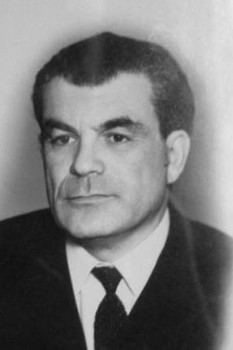 Mikhail Kliot-Dashinsky
Mikhail Kliot-DashinskyThe PhD of Physico-Mathematical Sciences, Associate Professor at the Department of Higher Mathematics of LISI (SPbGASU), survivor of the blockade, technical lieutenant of the Great Patriotic War Mikhail Kliot-Dashinsky (1923–2000) went through a difficult life path and left a bright mark in the history of the university, to which he devoted almost half a century.
Mikhail Isaakovich was born on 18 August, 1923 in Slavyansk, Donetsk region. His father worked as a merchandiser, his mother as a clerk. In 1924, the family moved to Moscow, and in 1930 to Leningrad, where they lived on Bolshoy Prospect on the Petrograd Side. In 1941, Mikhail graduated from school No. 70 in the Petrograd region and before being drafted into the army he worked as a turner at the Linotype plant.
Mikhail Isaakovich told the following story about the first winter of the siege. The section of Bolshoy Prospekt between Kamennoostrovsky Prospekt and the Karpovka River was paved with wooden end blocks. As a result of the explosion, these blocks flew onto the balcony of the Kliot-Dashinskys’ room. This saved them in the cold winter of the siege of 1941–1942: they used them to stoke the fire.
Upon conscription into the army, Mikhail Kliot-Dashinsky was sent to the Artillery Technical School. After graduating in January 1942, he served at the 55th artillery base of the Main Artillery Directorate of the Red Army as a pyrotechnician and head of the technical department. He finished his service with the rank of lieutenant technician.
In 1950, Mikhail Isaakovich graduated with honors from the Faculty of Physics of Leningrad State University. In September 1952, he was enrolled at LISI as an assistant at the department of higher mathematics. He gave lectures on higher mathematics to students.
In June 1958, Kliot-Dashinsky defended his thesis “On some variational methods for solving the first boundary value problem for equations of polyharmonic type in the case of two variables” for the degree of candidate of physical and mathematical sciences. His supervisor was Isidor Pavlovich Natanson, a leading specialist in the field of constructive mathematics, who headed the Department of Mathematics at LISI in 1943–1957.
In 1960, Mikhail Kliot-Dashinsky became a member of the Leningrad Mathematical Society. The scientist’s range of research was wide: radio frequency problems of geophysical exploration, problems of elasticity theory, potential theory, problems of geometric optics and laser spectroscopy (study of the interaction of modulated waves in quantum generators), electrical engineering, heat theory, filtration theory. His scientific works have been published in leading journals.
Together with Professor Sergey Nikolaevich Numerov, he developed the design and built the electrical integrator “LISI-I” for solving boundary value problems of field theory described by partial differential equations of elliptic type.
He wrote a lot of study guides for students, including those on the topic “Computers and Programming”, which was new not only for LISI, but also for all universities in the country, when in the 1960s LISI launched a new specialty “Computer technology in construction”.
In 1970, the first edition of his famous monograph “Algebra of Matrices and Vectors” was published, the method of presentation of which was highly appreciated by such outstanding algebraists as Z. I. Borevich and D. K. Faddeev. The book was published in several editions and is still in print today.
On 11 March, 1997, Mikhail Isaakovich wrote a list of his published scientific and educational works. It contains 53 items.
Mikhail Kliot-Dashinsky was awarded the medal “For Victory over Germany”, and the title “Veteran of Labor”.
Other materials of the "Scientific Regiment" project:
Our Graduate Built the Road of Life
Front Line of the Architect Aleksandr Nikolsky
Researcher who Developed Science in Besieged Leningrad
Fights of Student Klinov
Engineer of the 3rd Belorussian Front
Nineteen-Year-Old Gunner Stormed Berlin
Path of a Volunteer: from Front-Line Roads to Space Development
Ivan Solomakhin: "The Most Memorable Battle was for this Devil's Hill!"
Fiery Dnieper of the Hero of the Soviet Union Aleksandr Prygunov
Approaching to the Victory
Fedor Komal's Front: from the War Start to the Victory
Junior Political Instructor Boris Gubanov: “Shells Were Whizzing, and the Ground Took off Nearby”
Viktor Kvyatkovsky, Radio Reconnaissance Operator of the Baltic Fleet
How the Chief Architect Nikolai Baranov Kept Leningrad "Hidden" from the Enemy
Architect Nikolai Khomutetsky: Four Years at the Forefront
Semyon Shifrin Thwarted Nazi Plans to Leave Leningrad Waterless
LISI in the Post-War Years
LISI Graduate Mikhail Zherbin, Design Engineer and Composer
Abdulla Mangushev: Four Years at the Front and the Whole Life in Science
Architects Zazerskys Built and Defended the City on the Neva River